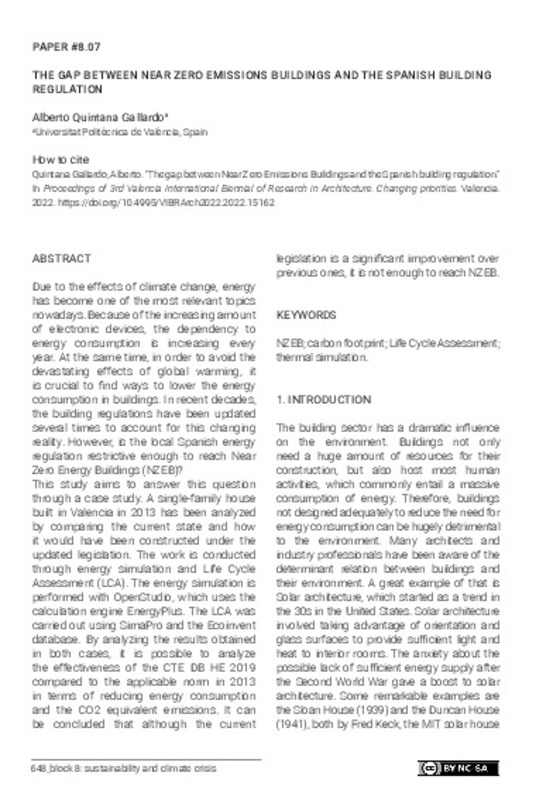JavaScript is disabled for your browser. Some features of this site may not work without it.
Buscar en RiuNet
Listar
Mi cuenta
Estadísticas
Ayuda RiuNet
Admin. UPV
The gap between Near Zero Emissions Buildings and the Spanish building regulation
Mostrar el registro sencillo del ítem
Ficheros en el ítem
| dc.contributor.author | Quintana Gallardo, Alberto
|
es_ES |
| dc.date.accessioned | 2023-12-21T13:01:29Z | |
| dc.date.available | 2023-12-21T13:01:29Z | |
| dc.date.issued | 2023-05-22 | |
| dc.identifier.isbn | 9788413960265 | |
| dc.identifier.uri | http://hdl.handle.net/10251/201025 | |
| dc.description.abstract | [EN] Due to the effects of climate change, energy has become one of the most relevant topics nowadays. Because of the increasing amount of electronic devices, the dependency to energy consumption is increasing every year. At the same time, in order to avoid the devastating effects of global warming, it is crucial to find ways to lower the energy consumption in buildings. In recent decades, the building regulations have been updated several times to account for this changing reality. However, is the local Spanish energy regulation restrictive enough to reach Near Zero Energy Buildings (NZEB)? This study aims to answer this question through a case study. A single-family house built in Valencia in 2013 has been analyzed by comparing the current state and how it would have been constructed under the updated legislation. The work is conducted through energy simulation and Life Cycle Assessment (LCA). The energy simulation is performed with OpenStudio, which uses the calculation engine EnergyPlus. The LCA was carried out using SimaPro and the Ecoinvent database. By analyzing the results obtained in both cases, it is possible to analyze the effectiveness of the CTE DB HE 2019 compared to the applicable norm in 2013 in terms of reducing energy consumption and the CO2 equivalent emissions. It can be concluded that although the current legislation is a significant improvement over previous ones, it is not enough to reach NZEB. | es_ES |
| dc.format.extent | 9 | es_ES |
| dc.language | Inglés | es_ES |
| dc.publisher | Editorial Universitat Politècnica de València | es_ES |
| dc.relation.ispartof | Proceedings - 3rd Valencia International Biennial of Research in Architecture, VIBRArch | |
| dc.rights | Reconocimiento - No comercial - Compartir igual (by-nc-sa) | es_ES |
| dc.subject | NZEB | es_ES |
| dc.subject | Carbon footprint | es_ES |
| dc.subject | Life Cycle Assessment | es_ES |
| dc.subject | Thermal simulation | es_ES |
| dc.title | The gap between Near Zero Emissions Buildings and the Spanish building regulation | es_ES |
| dc.type | Capítulo de libro | es_ES |
| dc.type | Comunicación en congreso | es_ES |
| dc.identifier.doi | 10.4995/VIBRArch2022.2022.15162 | |
| dc.rights.accessRights | Abierto | es_ES |
| dc.description.bibliographicCitation | Quintana Gallardo, A. (2023). The gap between Near Zero Emissions Buildings and the Spanish building regulation. Editorial Universitat Politècnica de València. 648-656. https://doi.org/10.4995/VIBRArch2022.2022.15162 | es_ES |
| dc.description.accrualMethod | OCS | es_ES |
| dc.relation.conferencename | 3rd Valencia International Biennial of Research in Architecture, VIBRArch | es_ES |
| dc.relation.conferencedate | Noviembre 09-11, 2022 | es_ES |
| dc.relation.conferenceplace | Valencia, España | es_ES |
| dc.relation.publisherversion | http://ocs.editorial.upv.es/index.php/VIBRArch/VIBRArch2022/paper/view/15162 | es_ES |
| dc.description.upvformatpinicio | 648 | es_ES |
| dc.description.upvformatpfin | 656 | es_ES |
| dc.type.version | info:eu-repo/semantics/publishedVersion | es_ES |
| dc.relation.pasarela | OCS\15162 | es_ES |








